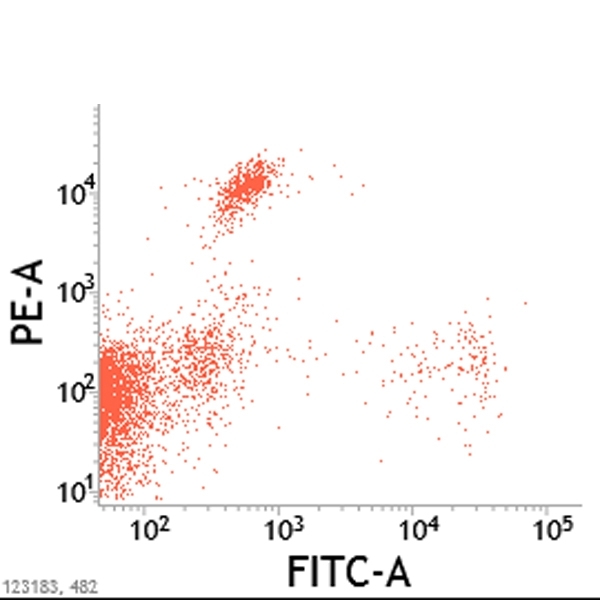CD8 Alpha/Beta antibody | vpg9

Mouse anti Cat CD8 Alpha/Beta
- Product Type
- Monoclonal Antibody
- Clone
- vpg9
- Isotype
- IgG1
- Specificity
- CD8 Alpha/Beta
| Mouse anti Cat CD8 alpha/beta antibody, clone vpg9 recognizes the feline homolog of human CD8. Clone vpg 9 specifically recognizes an epitope associated with the alpha/beta complex of the CD8 heterodimer (Shimojima et al. 1998). |
- Target Species
- Cat
- Species Cross-Reactivity
-
Target Species Cross Reactivity Human - N.B. Antibody reactivity and working conditions may vary between species.
- Product Form
- Purified IgG - liquid
- Preparation
- Purified IgG prepared by affinity chromatography on Protein A from tissue culture supernatant
- Buffer Solution
- Phosphate buffered saline
- Preservative Stabilisers
- 0.09% sodium azide (NaN3)
- Immunogen
- Feline thymocytes.
- Approx. Protein Concentrations
- IgG concentration 1.0 mg/ml
- Fusion Partners
- Spleen cells from immunized BALB/c were fused with cells of the NS0 mouse myeloma cell line.
- Regulatory
- For research purposes only
- Guarantee
- 12 months from date of despatch
Avoid repeated freezing and thawing as this may denature the antibody. Storage in frost-free freezers is not recommended.
| Application Name | Verified | Min Dilution | Max Dilution |
|---|---|---|---|
| Flow Cytometry | 1/25 | 1/200 | |
| Immunohistology - Frozen |
- Flow Cytometry
- Use 10μl of the suggested working dilution to label 106 lymphocytes in 100μl
| Description | Product Code | Applications | Pack Size | List Price | Your Price | Quantity | |
|---|---|---|---|---|---|---|---|
| Mouse IgG1 Negative Control | MCA1209 | F | 0.1 mg |
|
Log in | ||
| List Price | Your Price | ||||||
|
|
Log in | ||||||
| Description | Mouse IgG1 Negative Control | ||||||
| Mouse IgG1 Negative Control | MCA928 | F | 100 Tests |
|
Log in | ||
| List Price | Your Price | ||||||
|
|
Log in | ||||||
| Description | Mouse IgG1 Negative Control | ||||||
References for CD8 Alpha/Beta antibody
-
Willett, B.J., and Callanan, J.J. (1995) The expression of leucocyte differentiation antigens in the feline immune system.
P 3-15. In B.J. Willett and O.J. Jarrett (eds). Feline Immunology and Immunodeficiency. Oxford University Press, Oxford. -
Callanan, J. et al. (1993) Morphologic characterization of the lymph node changes in feline immunodeficiency virus infection as an animal model of AIDS.
In P. Racz, N. L. Letvin, and J.C. Gluckman (eds)., Animal models of HIV and other retroviral infections. S. Karger, Basel, Switzerland. P. 115-136. -
Shimojima, M. et al. (1998) Characterization of anti-feline CD8 monoclonal antibodies.
Vet Immunol Immunopathol. 61 (1): 17-23. -
Veir, J.K. et al. (2007) Effect of supplementation with Enterococcus faecium (SF68) on immune functions in cats.
Vet Ther. 8: 229-38. -
Pistello, M. et al. (2010) Env-expressing autologous T lymphocytes induce neutralizing antibody and afford marked protection against feline immunodeficiency virus.
J Virol. 84: 3845-56. -
Willett, B.J. et al. (2007) Probing the interaction between feline immunodeficiency virus and CD134 by using the novel monoclonal antibody 7D6 and the CD134 (Ox40) ligand.
J Virol. 81: 9665-79. -
Willett, B.J. et al. (2013) Selective expansion of viral variants following experimental transmission of a reconstituted feline immunodeficiency virus quasispecies.
PLoS One. 8 (1): e54871. -
Milner, R.J. et al. (2004) Suppurative rhinitis associated with Haemophilus species infection in a cat.
J S Afr Vet Assoc. 75 (2): 103-7.
View The Latest Product References
-
Rydzewski, L. et al. (2016) Identification of a novel feline large granular lymphoma cell line (S87) as non-MHC-restricted cytotoxic T-cell line and assessment of its genetic instability.
Vet Immunol Immunopathol. 177: 24-34. -
de Oliveira Medeiros, S. et al. (2016) Follow-up on long-term antiretroviral therapy for cats infected with feline immunodeficiency virus.
J Feline Med Surg. 18 (4): 264-72. -
Guzera, M. et al. (2016) The use of flow cytometry for immunophenotyping lymphoproliferative disorders in cats: a retrospective study of 19 cases.
Vet Comp Oncol. 14 Suppl 1: 40-51. -
O'Brien, T. et al. (2015) Moderate dietary supplementation with vitamin E enhances lymphocyte functionality in the adult cat.
Res Vet Sci. 99: 63-9. -
Sparger, E.E. et al. (2018) Investigation of immune cell markers in feline oral squamous cell carcinoma.
Vet Immunol Immunopathol. 202: 52-62. -
Maeta, N. et al. (2019) Lymphokine-activated killer cell transplantation after anti-cancer treatment in two aged cats.
Open Vet J. 9 (2): 147-50. -
Mustaffa-Kamal, F. et al. (2019) Characterization of antiviral T cell responses during primary and secondary challenge of laboratory cats with feline infectious peritonitis virus (FIPV).
BMC Vet Res. 15 (1): 165. -
Rütgen, B.C. et al. (2022) Composition of lymphocyte subpopulations in normal and mildly reactive peripheral lymph nodes in cats.
J Feline Med Surg. 24 (2): 77-90. -
Cha, S. et al. (2023) Non-B, Non-T Acute Lymphoblastic Leukemia in a Cat
Journal of Veterinary Clinics. 40 (4): 298-302.
- UniProt
- P41688
- P79336
- Entrez Gene
- CD8A
- CD8B
- GO Terms
- GO:0016021 integral to membrane
MCA1347GA
If you cannot find the batch/lot you are looking for please contact our technical support team for assistance.
Please Note: All Products are "FOR RESEARCH PURPOSES ONLY"
View all Anti-Cat ProductsAlways be the first to know.
When we launch new products and resources to help you achieve more in the lab.
Yes, sign me up